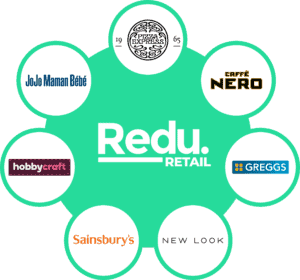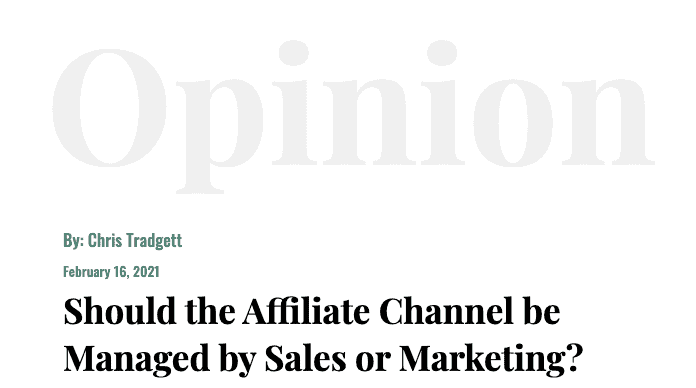This article first appeared in Martech Record
Is it time we stopped thinking of e-commerce as a single channel?
“Affiliate Marketing” has suffered from an ongoing issue as many advertisers manage affiliates as a function and a cost item within the marketing department. Affiliate’s main strength comes from being a pay-for-performance channel. However, as Marketing is viewed as an expenditure within company accounts, many advertisers saddle their affiliate program with very real functional problems.
So, should affiliate marketing be moved out of marketing completely? For many more progressive companies, sales and marketing operate together in a much more integrated way than the more traditional model that kept them siloed.
Affiliate Program “Hitting Budget”
With many programs forced to manage affiliates by a monthly budget, it’s like holding a greyhound on a short leash. I have come across many instances of affiliate programs pausing activity during a month that they “hit budget” – which is a strange situation to be in when the advertising cost is only paid out after a sale is made.
Of course, there are program aspects that are not pure CPA. Since the early 2000s, high-traffic and destination-affiliate websites have commanded a tenancy or placement fee to ensure exposure. Pausing that element of a program is entirely understandable.
I have long argued, however, that affiliate commission fees should be both viewed and managed as a Cost of Sale. This issue has given rise to some huge issues in affiliate marketing during the Covid pandemic, affecting online brands and affiliates.
Winners and Losers
For most consumer facing online advertisers, a rapid and systemic re-evaluation of an ecommerce model was necessary to keep up with massive change. For those who were able to continue trading normally, many saw a significant uptick in sales volume.
 The DIY and outdoor verticals were amon the biggest winners. For some, including DIY, the increase in sales volume coincided with challenges in supply and distribution; B&Q and Wickes in the U.K., for example, had to choke website access. Customers were waiting up to 45 minutes to even see the website and many items quickly went out of stock as manufacturing was just not happening in many cases.
The DIY and outdoor verticals were amon the biggest winners. For some, including DIY, the increase in sales volume coincided with challenges in supply and distribution; B&Q and Wickes in the U.K., for example, had to choke website access. Customers were waiting up to 45 minutes to even see the website and many items quickly went out of stock as manufacturing was just not happening in many cases.
Affiliate agency Optimus-pm reported that their client Yougarden.com saw a 10x growth in sales, and online drink retailers saw similarly high increases in sales. Where some paused their marketing activities, the affiliate element was usually last to be affected.
For some, as in the DIY examples, the overall demand was so great that they had to manage affiliates' activity in order to manage customer expectations. Affiliates were generally understanding of the issues that retailers were facing and adjusted their sites and activities accordingly.
Some advertisers were less considerate to their affiliates. Matalan closed their program completely with just a note placed on the network page. Affiliates were given no notice or message.
The travel vertical was among the hardest hit. Most airlines and hotels providers paused or stopped almost immediately. Marriott went to the extent of closing their affiliate program, meaning that all the adverts on affiliate websites linked to the affiliate network 404 page. This was damaging to the affiliate and the network, but maybe more damaging to Marriott as a brand. As for Matalan, it’d likely be difficult to restart a closed program.
Had Marriott only paused the payment element and allowed links to refer through, these issues could have been avoided. Their affiliate base would also have remained engaged; most are fully commercially aware and would understand Marriott’s predicament. What’s more, these affiliates would still be in place once the market picks back up — something like a free night stay for each affiliate would have been a great (and inexpensive) way for Mariott to show gratitude for that understanding.
The Affiliate View

A leading U.K. affiliate, Redu, said they had to be more tactical with less frequent activity and had to react quickly to changes. For example hot tubs were in huge demand and then out of stock soon after. Redu’s ongoing view of an advertiser will, of course, be colored by how they responded to 2020. It’s fair to say that those merchants who treat their affiliates as relationships as opposed to expendable media will be most successful in re-starting their campaigns.
For them, as with many other larger affiliates, up to 50% of overall revenues came from tenancy or placement fees, which dried up along with most other examples of paid advertising. That showed that many advertisers are treating the affiliate activity differently now - as a cost of sale.
Some companies like Mariott and Matalan are likely still running highly separate departments. That divided model leads to problems with managing affiliates. It is high time that more marketers moved away from the outdated silo mentality and toward a fully integrated marketing approach. Affiliate publishers monetize their properties in a variety of ways so silo separations often make little sense.
With automation systems, it is now so much easier to manage this broader view of overall marketing with a single view of truth. Software like Marketo, Pardot and Hubspot make this so much simpler than it was in previous years. But as we see, so many marketing organizations have not kept in step with the technologies available and still manage advertising in silos. This inevitably leads to disjointed presence across channels.
So How Will We Recover?
As ecommerce operations are dealing with the aftermath of the biggest online Q4 in history, how should those who manage affiliates prepare for the changed landscape of 2021?

For many in ecommerce, the move from offline to online has already been underway. Industry intelligence reveals that many U.S. retailers are again not planning to open on Thanksgiving in 2021 and are redirecting their Black Friday 2021 focus to online. In recently published statistics, Q1 to Q2 2020 growth was equivalent to the previous three full years!
All sectors will slowly recover, though it may take longer for industries like travel and tourism. They will recover within a new landscape that has shifted increasingly away from brick and mortar. The companies that will survive and thrive will be those that are most agile and adaptable to the “new normal.” To be in that position, companies will need to do three things:
Re-examine their markets fully and be prepared to adapt quickly to the new shape of business, or perhaps prepare for two potential outcomes:
- Innovate and re-imagine their company to fit these new market conditions
- Stay agile and prepared to change things to fit the market - dealing with affiliate fees as a cost of sale as opposed to media spend is the first step towards this.
It has been interesting to see the attitude changes in the recent 2021 industry prediction blog posts (as in our own article). There has definitely been what seems to be a more permanent shift toward performance advertising. As any area of performance is naturally based on a cost of sale, it is even more pertinent to argue that brands should manage affiliates as a Sales input - rather than as a Marketing spend.

Originally published in February 2021 in Martech Record as "Should the Affiliate Channel be managed by Sales or Marketing?"
Chris Tradgett
See further Affiliate Management Articles >
Get blog updates to your inbox
By clicking Subscribe you are agreeing to receive email marketing communications from Publisher Discovery. We will not share your details with any 3rd parties and you can change your preferences at any time. Please review our Privacy Policy for more information.

